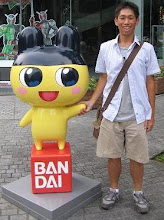今週の漢字: 買物
Shopping:
During the past few months, my bank accounts have been slapping me silly. I’m reminded to keep watch of my finances. I really don’t like to do it, because it saddens me sometimes. Being in a foreign country, there are many things I want to do. Most of the activities I have done so far are things that I can do back in America, but I find it fun to compare and contrast. Of course, there are places I visit and things I do that aren’t done in the U.S. For this topic of shopping, I don’t want to write about places, but I want to point out some interesting differences.
Let’s look into stores first. In America and many other countries, the payment flows from the consumer’s hands directly into the hands of the clerk. Usually, it is different in Japan. When I first went into a store within merely a day of arriving, I bought a cheap electric razor (I left mine in my luggage that was sent to my town). Not only was I at a loss of what seemed like fast gibberish spewing out of the clerk’s mouth with ease, I didn’t know how to pay for my desired good. I remember the clerk just standing there as I had the money all ready. She thought that I wasn’t finished getting the amount I wanted to pay. I felt uncomfortable and looked at the neighboring consumers. They were all like drones conditioned on how to pay in stores from what seemed like before birth. It was a really busy store with people going in and out. Seriously, I felt like I was watching one of those cartoons where people walk into a building using a revolving door only to exit seconds later having accomplished their goal. Anyway, getting back to my dilemma, I figured out what I needed to do. I put the money on a tray that was in front of the clerk. She took the payment and gave me the correct change. Sometimes I still forget to put my yen on the tray, but there have only been maybe five places so far where I gave my money directly into the clerk’s hands. I don’t really know why this way of paying is done.
If you think this is only done in stores, you’re wrong. This is also done in most restaurants. When the waiter gives me the bill, I don’t give the payment to the waiter. No, I have to pay usually near the door where there’s someone to collect the bill and money. In America, there are some restaurants that utilize this way of paying the bill, but it’s rare.
I think one of the best things about shopping in Japan is that the price seen is exactly the price paid. Tax is already included and tipping isn’t a custom in Japan, so I can easily calculate the price most of the time. Occasionally, I struggle with math as it is slowly escaping my brain. For example, I felt like long division was against me a few weeks ago. Well, it wasn’t so bad, but it definitely wasn’t as fast compared to before college. Somehow, I’m more comfortable with calculus. I wonder what will happen six years from now. Maybe I’ll lose my English too. Anyway, I don’t know why I’ve been going off on strange tangents lately, but I think my tangents make conversations lots of fun. I am proud of my weirdness… most of the time… inside my head… while I’m in denial. I haven’t found many people who share the same sense of humor. If you found anything funny in this post, we would make good friends if we aren’t already.
Stay tuned next week for another update!
En français:
Quand je vais au supermarché, l’employé me donne des sacs en plastique (je ne sais pas si c’est le vocabulaire correct) pour mes articles d’épicerie. La première fois, j’étais surpris parce qu’en États-Unis, l’employé les met dans des sacs. Je pense que le système en japon est meilleur. La queue avance plus de rapide, mais si le marché est très fréquenté, il n’y aurait pas assez de place pour de mettre les articles.
今週の聖書の詩: “Do not love the world or anything in the world. If anyone loves the world, the love of the Father is not in him. For everything in the world—the cravings of sinful man, the lust of his eyes and the boasting of what he has and does—comes not from the Father but from the world. The world and its desires pass away, but the man who does the will of God lives forever.”
- 1 John 2:15-17 (NIV)
I wrote about money and shopping, but it’s important to keep this passage in mind. I find it troubling when people focus on money. Where will money get you? What will money do for you? Ultimately, it gets you nowhere and does nothing. It’s because of society that money is what people worship. In the long run, money does not follow us when we die. It will do nothing for us when we die. The importance of money is simply a societal construct.
今週の写真: I went to a hot spring at Yuya in my prefecture. It was so nice. The custom is basically the same as common baths (look at my post two weeks ago if you don’t know). I don’t like to be naked with other men, but the water was so relaxing. I highly recommend visiting a hot spring at least once. Aaaaahhhhhhhh…









































